#Human development
Explore tagged Tumblr posts
Text
"In one of the more remarkable marches of human progress, Bangladesh has reached the point of near-universal electricity access for its citizens.
Coupled with the rapid electrification has been one of the greatest single declines in the poverty rate of a nation ever seen, falling from 44.2% in 1991 to 18.7% in 2022.
In 1991, only 14% of the nation had access to electricity. By 2021, 99% had access.
Granted, half of these households are considered according to Our World in Data to have lower tier access, which accounts for home lighting and charging mobile phones at least 4 hours a day, but the other half are considered as having higher tier access, defined as the added capacity to power high-load appliances (such as fridges) for more than eight hours a day.
Bangladesh is the world’s most densely populated large country with a density of 3,020 per square mile. As the twelfth densest country in the world, the 11 above Bangladesh are all microstates whose combined land area would not even equal half the size of the smallest state in Bangladesh.
To put this into perspective, (a rather silly perspective) if one wanted to reduce the population density of Bangladesh to that of Mongolia, its borders would have to include both all of Africa and all of Eurasia. That’s how crowded Bangladesh is, and what these amazing reductions in poverty truly mean to global human flourishing."
-via Good News Network, January 21, 2025
--
Note: This is the kind of thing I mean when I say that very, very few people in the West know the degree to which absolutely massive societal progress has been happening in a lot of different developing countries.
Especially around access to infrastructure and access to electricity.
The quality of life improvements to electricity access are massive.
It's not just access to phones/the internet (already a huge deal that opens up massive channels of communication and information-sharing).
It's being able to preserve food because you have a fridge, meaning you get to spend less money on food/have less food waste/run fewer errands/have way more flexibility around food.
It's being able to do things after dark, because you have a lightbulb. It's being able to work late, make more of your time.
It's less air pollution because people can use electricity instead of burning fuel for things like heat/light/cooking. (Yes I know these things often use fuel or natural gas still, but they can be done with electricity, and a lot of developing countries are skipping over a natural gas/etc. phase and straight into renewables.)
Hell, it's safety. I had a friend when I was younger who was from southeast Asia. She was horribly injured when she was a kid because her family only had kerosene oil lamps that had to be manually refilled. If her family had had access to electricity, that never would have happened.
It's infrastructure for heating, air conditioning, and water access. It's so, so many things. It's huge.
878 notes
·
View notes
Text
"We live in capitalism.
Its power seems inescapable.
So did the divine right of kings.
Any human power can be resisted and changed by human beings.
Resistance and change often begin in art,
and very often in our art, the art of words."
- Ursula K. Le Guin, US-american Author and "Activist of the Imagination".
#quote of the day#quote of today#ursula k. le guin#history#humanity#periods of history#human development#capitalism#power#human power#misuse of power#divine right#kings#queens#rulers#absolutism#authoritarianism#tyranny#action#resistance#change#a change is gonna come#art#art of words#creativity#what matters
117 notes
·
View notes
Text
So as someone who's taken a college biology class with an entire unit dedicated to sex differentiation it's been bugging me immensely to see so many people (mostly on threads) say that "we're all female at conception" There's some truth to female anatomy being the "default baby" because it takes less developmental energy to create/maintain but "we're all female to start" is a way oversimplification of this to the point it's just not true. I'm not claiming to be an expert by any means but I would like to spread the knowledge I do have bc I think it's honestly cool as hell
To start I've seen this talked about a lot in relation to Trump trying to sign an executive order that categorizes people's sex by "the gametes they have at conception" There's so many issues with this. A zygote is not producing gametes at conception, it's a single cell. A zygote carries the genetic coding for which sex you are but genes are not the final determination and only make up part of your sex. For example, you may have an SRY gene which is the catalyst for male development but it may be damaged and not expressed. A person may present entirely as one sex but not be able to produce gametes, Sex isn't just one characteristic.
Once a fetus begins developing its organs it doesn't just start out with female anatomy which can then "become male anatomy if you have the genes for it" We actually start out with undifferentiated gonads (which are still not producing gametes) and two duct systems, one that can become the female reproductive organs and one that can become the male. They're called the Müllerian and Wolffian ducts. (Science illustration so you know I'm not just pulling this out of my ass)
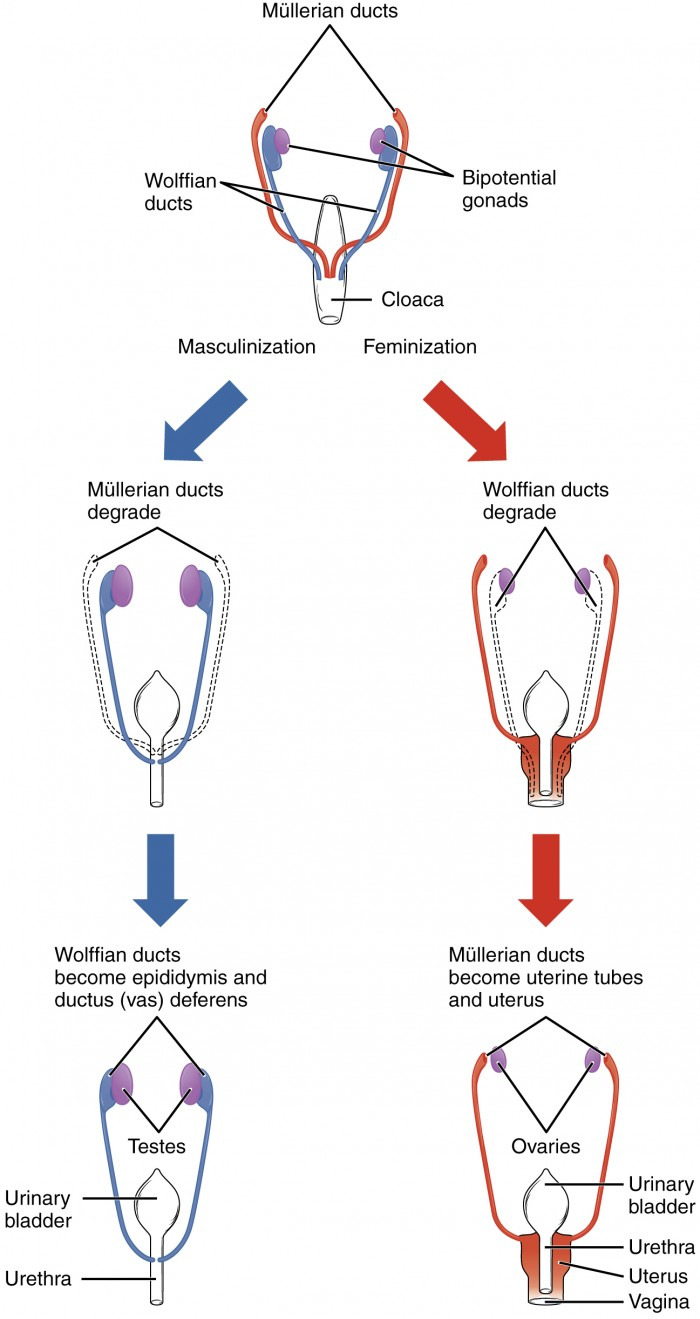
This is where our genes come into play deciding if our gonads become ova or testes and which ducts develop into our reproductive organs. Shout out to all my intersex folks, a lot of intersex conditions become expressed at this stage of development. For example, a person with androgen insensitivity syndrome would have XY chromosomes but would have missing or non-functioning androgen receptors. This means their gonads become testes and the hormone that degrades the Mullerian ducts is released, but their body cannot use any androgens to continue male development. This means without androgens the wolffian ducts also degrade and the person would have external female genitalia and internal testes. My knowledge on the more micro-biology and chemical reactions part of sex determination is more limited so I can't really talk about it in a comprehensive way but I just wanted to share this really cool human fact.
#biology#human development#science#sex determination#human rights#human biology#no we're not all female at conception#and that's a rock fact
87 notes
·
View notes
Text
Spinning Plant and Animal Fibers
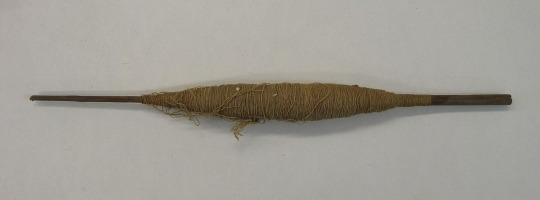
By Brooklyn Museum - Spindle without Whorl, whole or Spindle with Cotton Yarn, Fragment. Brooklyn Museum. Retrieved on 2019-11-04.Attribution 3.0 Unported (CC BY 3.0) license, CC BY 3.0, https://commons.wikimedia.org/w/index.php?curid=83653957
The beginning of twisting fibers from plants or animal coats is difficult to date because they don't fossilize, so we have to rely on trace evidence, such as imprints in mud that did fossilize. We have these of string-like skirts from the Upper Paleolithic that date to about 20,000 years ago. Recent discoveries, though, show that Neanderthals spun cording as well.
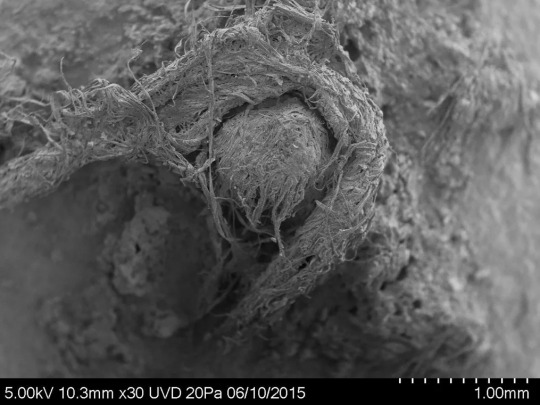
Photo of Neanderthal cord from Abri du Maras. M-H. Moncel
The evidence from the Neanderthals was actual fibers that were preserved in a cave in southern France. The fragment was 6mm long and was three bundles of twisted tree fibers twisted together. The most likely usage of the fiber was to be wrapped around a handle of some type or as part of a net bag. This implies many areas of knowledge held by Neanderthals to make the cording including the growth patterns of the trees the fibers came from, spinning, and spinning the resultant thread into a stronger yarn. 'In order to get this fiber, you have to strop the outer bark off a tree to scrape off the innter bark. This is best done in the spring or early summer,' according to Bruce Hardy, co-author of the study of these fibers and professor of anthropology at Kenyon College in Gambler, Ohio.
This spinning was most likely done against the thigh, twisting the fibers as the hand rolls it down the thigh, pinching them, and then bringing them back to the top of the thigh to be twisted more. The product was likely wound around a stick or stone.
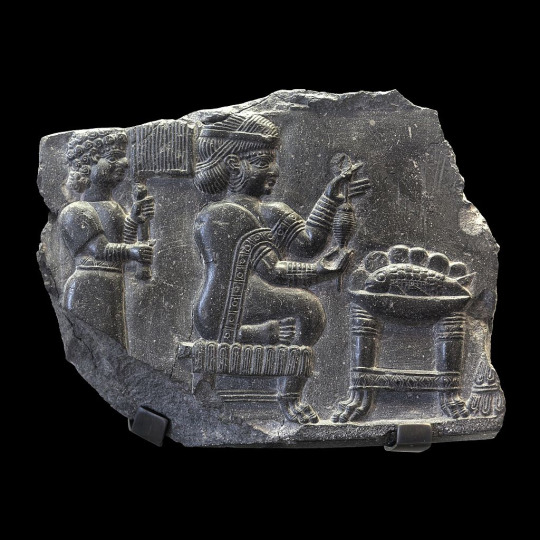
By Rama - Own work, CC BY-SA 2.0 fr, https://commons.wikimedia.org/w/index.php?curid=49227927
The next step was to spin onto the stick, or spindle, directly, then to create a split or hook in the top of the stick to hold the twisted part on the stick. Exactly when this happened, we don't know, as there are, as yet, no direct remains of this process. What we do have evidence of improved technology is small bone and later metal hooks that replaced the slit or hook cut into wood as well as weights made of stone, wood, metal, clay, or later metal that went on the end of the sticks to keep them spinning longer called spinning whorl. These have been found as early as the Neolithic. The combination of these technological improvements is called the drop spindle and we have artwork depicting spinning from many cultures.

By © Marie-Lan Nguyen / Wikimedia Commons, Public Domain, https://commons.wikimedia.org/w/index.php?curid=2596494
The other item needed to make spinning easier is an item called a distaff, which would hold a prepared bundle of fibers is loosely wrapped onto, which freed the hand that would have previously held the fiber and allowed a larger quantity of fiber to be held at one time. The distaff could be tucked under the arm or into a loop or holder in a belt. Again, since this didn't fossilize, we don't know when it was developed, though it does appear in Bronze Age artwork.
If you're interested in learning to spin, local independent yarn stores are a good place to start. Other places to look are reenactment guilds, fiber craft guilds, or online for spinning classes. The benefit of guilds is in-person help learning and the benefit of companionship and experience.
59 notes
·
View notes
Text

Wildcat (2023) by Ethan Hawke
Book title: Human Development
#wildcat#maya hawke#ethan hawke#human development#books in movies#fictitious books in movies#fictitious books#christine dye
29 notes
·
View notes
Text
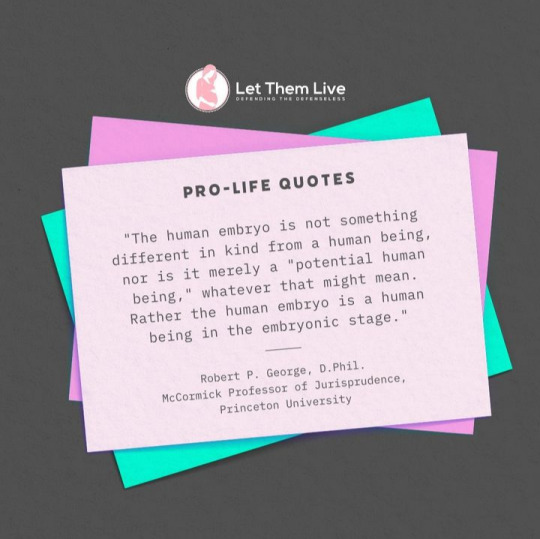
#let them live#abortion#anti abortion#pro life#pro life quote#quote#embryology#science#human development
86 notes
·
View notes
Text
People don’t seem to understand just how important connection is for babies, even just at a few months old. And I don’t just mean for physical health. In psychology, there’s a series of dilemmas that every age group has to go through. For example, I am currently in the identity vs role confusion stage. And newborns have a stage too, that being trust vs mistrust, from ages 0-1 years. If their caregiver is not providing them the proper attention, even if it’s so much as taking too long to get to the baby while they’ve been crying for too long, the baby will develop mistrust. And this could develop into unhealthy attachment styles. Kids who are extremely clingy and attached to their moms, or kids super distant and unresponsive to their moms. From the very beginning, human connection is going to affect the kind of person you will grow into.
#psychology#psychblr#human psychology#important#interesting#Socioemotional theory#erik erikson#Childcare#psychology student#Development#human development
9 notes
·
View notes
Text
There Is No Maternal Instinct In Humans
By definition, an instinct is a behavior that does not have to be learned, shows almost no variation between members of its species, and manifests in a rigid sequence of behaviors performed in response to stimulus. It's also called a fixed action pattern, or FAP. In bears and pigeons, hibernation and homing are instincts. In some species, caring for newborns is instinctive. [...] A rat has a maternal instinct. So, too, does the grayback goose, who immediately pushes any round object near her nest inside to incubate it, no matter if it is a billiard ball placed there by an impish ethologist or an actual egg. Round object (stimulus) produces rolling behavior (response). The less intelligent an animal, the more its survival depends on instinct. In contrast, almost every aspect of primate behavior is mediated by a larger and more developed brain. Evolution has equipped us with a neocortex that requires us to learn in order to survive. With a neocortex, biology remains relevant but is no longer determinant. Natural selection ultimately favored flexibility. Animals that can rapidly adapt to shifting conditions have an advantage over those that can survive only a narrow range of circumstances. [...] The neocortex allows flexibility, but the loss of instinct also comes at a cost. Charles Snowdon, a professor emeritus at the University of Wisconsin, has spent his career studying marmosets and tamarins, cooperatively breeding New World monkeys. In most groups of tamarins, the young help to take care of babies, while in a minority of groups, they do not have this opportunity. In a field study of tamarins without prior infant-care experience, Snowdon and his team discovered that babies born to first-time parents never survived. They guessed that naive mothers and fathers didn't know enough either to parent on their own or to accept help from more experienced kin. Later, from comparative data, his team discovered that the survival rate was much better in groups where young siblings helped out with babies. Across primates, infants born to inexperienced parents have higher risk of death. Snowdon explains, "When they don't have experience with infant-care skills, there's a very low breeding success rate. Parenting skills are learned. They're not innate, for males and females equally. Both are clumsy parents. [...] You have to learn to share care of your baby[...]"
- Darcy Lockman (All the Rage: Mothers, Fathers, and the Myth of Equal Partnership, pages 71, 71-72, 73-74). Slightly reformatted to avoid wall of text, bolded emphases added.
70 notes
·
View notes
Text
The infant, being unable to conceal well, suppresses feeling internally in order to minimize them externally. He becomes disconnected from his feelings and comes to believe that his needs are minimal. The adult counterpart of this strategy is found in the dismissing speaker ... feelings of need and hurt are minimized, memory for childhood is scant, and the importance of attachments is questioned. An important part of controlling the expression of need is to keep it from consciousness. If it is not known consciously, it does not exist. To the extent it is known, it is devalued.
Alan Sroufe, Attachment and Human Development
91 notes
·
View notes
Text
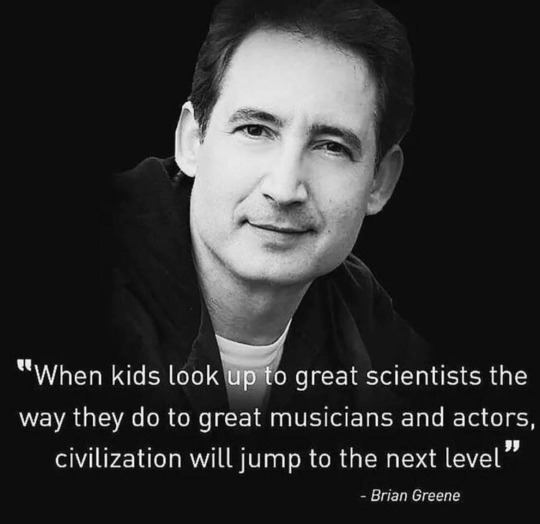
"When kids look up to great scientists the way they do to great musicians and actors, civilization will jump to the next level." -- Brian Greene
48 notes
·
View notes
Text
The global number of children not attending school has declined by nearly 40% since 2000

Note: Some definitions, though this varies by country and there does not appear to be a universally agreed-upon definition. Primary school = roughly 5 to 10 years old = elementary school Lower-secondary = roughly 11 to 14 years old = middle school Upper-secondary = roughly 14 to 18 years old = high school
"The chart shows the global number of children and adolescents who are not in school across primary and secondary education.
According to the most recent UNESCO data, this number has fallen from 390 million in 2000 to 244 million in 2023. That’s nearly a 40% reduction. The global population of children has grown during this time, making the decrease in out-of-school children even more significant.
Many more children are getting an opportunity to learn now than 20 years ago, but progress has stagnated in the last five years. [Note: A significant amount of that no doubt due to the pandemic.]
Historically, more girls than boys were out of school, but this gap has nearly closed. Unfortunately, the global aggregate data split by gender has not been updated by UNESCO since 2019. This makes it hard to track recent progress between boys and girls."
-via Our World in Data, July 29, 2024
#school#primary school#secondary school#kids#adolescents#school system#human development#global development#education#good news#hope
298 notes
·
View notes
Text
Dear My First Son

Menjadi anak pertama dan paling besar dalam keluarga punya situasi dan kondisi tertentu. Sebenarnya bukan benar-benar yang pertama karena sebelum kamu, telah lahir seorang putri. Qadarullah putri mungil, kakak kamu itu telah kembali ke pemilikNya saat masih bayi yang didahului kondisi ia diserang demam tinggi. Beberapa bulan kepergiannya, alhamdulillah Allah izinkan bunda mengandungmu. Setelah sembilan bulan lebih beberapa hari, lahirlah kamu dengan selamat dan dalam keadaan sehat.
Dimulai sejak kelahiranmu kami sebagai orang tua yang diberi kesempatan kembali memiliki anak, menyambutmu dengan limpahanan suka cita. Kamu seperti harta karun yang dinantikan, yang harus dijaga dengan sangat hati-hati agar kamu selalu merasa nyaman tidak ada penderitaan, tidak terkena penyakit. Kami masih sangat trauma dengan peristiwa yang dialami oleh kakak kamu sebelumnya. Yah begitulah perlakuan kami terhadapmu.
Wahai anak pertama, keturunan yang dinanti-nanti. Kami diliputi perasaan antara bahagia dan cemas. Bayang-bayang kehilangan kembali sering menggelayut di pikiran setiap kamu menunjukkan tanda sedang kurang prima. Akh trauma ini sungguh melekat kuat di memori, dampaknya memengaruhi respon kami setiap kamu mengalamai hal-hal yang tidak biasanya : kurang sehat, rewel dan lainnya.
Perhatian kami benar-benar terpaku pada dirimu. Tanpa sadar kami membentengi dirimu sebisa mungkin, menghindarkanmu dari kuman dengan melarang bermain tanah dan yang kategori kotor (sumber kuman) menurut kami. Kami menjelma menjadi orang tua super protektif. Apa-apa dilarang agar keadaanmu tetap hygiene. Tidak boleh ada suara berisik sedikit pun agar kamu dapat tidur nyenyak. Kami berpikir itu adalah langkah terbaik bagi kami untuk melindungimu.
Pernah sekali kamu mengalami demam tinggi, bukan main paniknya kami hingga terbirit-birit ke RS. Kamu langsung opname, mendapat cairan infus yang membuatmu sangat ketakutan dan tidak ingin berbaring di kasur. Akhirnya Ayah kamu yang menggendongmu sepanjang malam hingga kamu terlelap. Esok hari hasil uji lab kamu keluar, ternyata ada infeksi dengan indikasi tingginya leukosit dalam darah kamu. Menurut petugas medis kejadian seperti ini adalah hal biasa dialami oleh anak-anak. Yang penting segera mendapat obat penurun demam. Mendengar penjelasan ini tidak serta merta menurunkan level kecemasan kami. Bayangan takut kehilangan berulang lebih kuat mengitari pikiran kami. Sudah pasti kami tawakkal dengam ikhtiar yang dilakukan tapi tidak sanggup meniadakan rasa cemas yang ada.
Tahun demi tahun berganti, lahirlah satu per satu adik-adik kamu. Tentu perhatian kami sudah pasti terbagi dan berusaha memberikannya secara adil. Jika kalian menilainya ada yang tidak adil itu adalah faktor sudut pandang saja. Mudah-mudahan kalian mampu melihatnya dari segala sisi.
Wahai anak pertamaku, kini kamu sudah remaja. Bukan lagi seoarang bayi seperti dulu. Sekarang kami menjagamu dalam bentuk lain. Mungkin kamu merasa yang paling sering mendapat ceramah alias nasihat tentang masa depan. Nasihat tentang kedisiplinan, kesuksesan dan seterusnya. Mungkin kamu muak dengan semua petatah petitih itu semua. Tapi ketahuilah bahwa kami menaruh harapan besar padamu sebagai anak tertua, patut menjadi contoh teladan bagi adik-adikmu. Tentu kami sadar, kamilah yang seharusnya menjadi contoh terlebih dahulu. Tentu ini kami upayakan demi kamu dan adik-adikmu.
Harapan besar ini kadang menggiring kami ingin melihatmu selalu terlihat sempurna, tak ada salah. Akhirnya tak jarang kami terutama bunda lebih sering melihat kesalahanmu daripada memgapresiasi apa yang sudah baik yang sudah kamu lakukan dan capai. Ketakutan jikalau masa depan kamu suram, menjadi prmantik sebagai alasan melakukan cara ini. Kami ingin memastikan kamu berada di jalur yang benar, berkarakter yang produktif. Mungkin kamu sangat jengah dengan perilaku kami ini.
Banyaknya sumber distraksi yang harus kamu hadapi saat ini, ditambah ketakutan tentang masa depanmu menjadi alasan bagi kami untuk lebih sering mengingatkanmu. Mungkin cara yang kami pilih bukan yang menyenangkan bagimu tapi ketahuilah harapan terbesar kami adalah ingin kamu selamat, bahagia dan sejahtera di kehidupanmu kelak.
Bunda, Ayah harus banyak minta maaf kepadamu jika selama mendampingimu hingga saat ini banyak kalimat maupun perbuatan yang menyakitimu tanpa kami sadari. Maafkan kami yah nak. Semoga Allah melimpahkan kebaikan dan menunjukkan jalan yang ideal lagi agar kita sekeluarga sama-sama mencapai harapan yaitu menjadi manusia yang Bahagia dan Bermanfaat, Aamiin.
3 notes
·
View notes
Text
The Philosophy of Economic Development
Economic development refers to the process through which a country or region improves its economic, social, and political well-being. It goes beyond mere economic growth, focusing on broader improvements such as quality of life, equitable access to resources, and sustainability. The philosophy of economic development involves the exploration of values, principles, and strategies that guide efforts to elevate living standards, reduce inequality, and promote social justice.
Core Principles of Economic Development
Human Well-being and Quality of Life Economic development is not just about increasing wealth, but improving the overall quality of life. This involves not only economic metrics like income and employment but also health, education, access to basic services, and environmental sustainability.
Sustainability Sustainable economic development ensures that current growth does not come at the expense of future generations. This encompasses responsible resource management, environmental protection, and long-term social stability.
Equity and Inclusiveness Development should aim to reduce inequality, ensuring that the benefits of growth are shared equitably among all segments of society. This often includes addressing poverty, gender inequality, and regional disparities.
Freedom and Empowerment The philosophy of economic development values individuals’ freedom to choose their path in life. This involves creating an environment where people can access opportunities, make decisions, and have control over their economic futures.
Participation and Democracy Genuine development is participatory and involves empowering local communities. Democratic governance structures enable people to take part in the decisions that affect their lives, ensuring that development initiatives reflect local needs and aspirations.
Philosophical Approaches to Economic Development
Neoliberalism Neoliberal thinkers advocate for minimal state intervention in the economy, believing that market forces, competition, and private enterprise lead to more efficient allocation of resources. They argue that deregulation, privatization, and free trade stimulate economic growth and improve living standards.
Structuralism Structuralist approaches, rooted in the works of economists like Raul Prebisch, argue that development requires transforming the economic structure of a society. This may involve diversifying economies away from primary exports and fostering industrialization, technology, and education. Structuralism also advocates for addressing historical inequalities between developed and developing nations.
Dependency Theory Dependency theory critiques the global economic system, arguing that poorer nations remain economically dependent on wealthier ones. It asserts that economic development cannot occur without addressing global inequality and suggests that developing countries should resist exploitative international systems and focus on self-sufficiency.
Capabilities Approach Developed by philosophers like Amartya Sen and Martha Nussbaum, the capabilities approach focuses on expanding individuals' abilities to achieve their well-being. Development is seen not just as economic output but as the expansion of freedoms, opportunities, and capacities to lead a fulfilling life.
Human Development and Well-being Human development, as championed by the United Nations Development Programme (UNDP), emphasizes improving people’s lives through access to health, education, and economic opportunities. It expands the concept of development beyond GDP growth, focusing on broader human development indicators.
Ethical Considerations in Economic Development
Justice and Fairness Economic development often raises ethical questions about fairness and justice. How do we ensure that the fruits of development reach the most marginalized? Are the benefits of growth distributed equitably?
Cultural Sensitivity Globalization and development may clash with local traditions and ways of life. How can development policies respect cultural diversity while promoting progress?
Environmental Responsibility The growth that drives economic development can often harm the environment. Ethical economic development seeks to balance economic success with ecological sustainability, protecting ecosystems and promoting green technology.
Rights-Based Development Some philosophies assert that economic development should be driven by respect for human rights, focusing on the right to work, access to education, the right to food, and social security. Rights-based frameworks aim to ensure that development benefits all people, particularly the most disadvantaged.
Challenges and Criticisms
Economic Inequality While economic development can lead to prosperity, it often exacerbates social inequality. The gap between the rich and poor, both within nations and globally, remains a persistent challenge in achieving truly inclusive development.
Sustainability Issues Rapid economic development can result in environmental degradation, depletion of natural resources, and long-term ecological damage. The challenge lies in balancing immediate economic gains with the need for environmental stewardship.
Cultural Imperialism Economic development often brings Western-style capitalism, technology, and values into non-Western societies, leading to criticisms of cultural imperialism. These critiques question whether true development is possible without compromising cultural identity.
Political Corruption and Mismanagement In many countries, political corruption, ineffective governance, and the lack of infrastructure can hinder the success of economic development initiatives. Ensuring transparent, accountable leadership is essential for sustainable progress.
Conclusion
The philosophy of economic development encompasses diverse theories and practices aimed at improving the well-being of individuals and societies. At its core, it recognizes that economic growth is not an end in itself but a means to greater human flourishing. By addressing the ethical, social, and environmental dimensions of development, philosophers and policymakers alike strive to create an equitable, just, and sustainable future for all.
#philosophy#epistemology#knowledge#learning#education#chatgpt#economics#Economic Development#Development Philosophy#Philosophy Of Economics#Economic Justice#Global Development#Sustainable Growth#Moral Economy#Socioeconomic Ethics#Growth And Ethics#Development Theory#Human Development#Equity And Economics#Philosophy Of Progress#Political Economy#Economic Ethics
2 notes
·
View notes
Text
Clothing and Decoration

By Oguenther at German Wikipedia - Own work, Public Domain, https://commons.wikimedia.org/w/index.php?curid=15134201
Humans have been decorating themselves at least 100,000 years, perhaps as long as 300,000 years, beginning with ochre, a pigment that comes in shades from yellow to purple. Ochre was used for tools and to create pigments that decorated the skin, paint cave walls, and as part of burial rituals, even medicinally. The evidence we have are depictions of human figurines made of limestone and decorated with ochre.
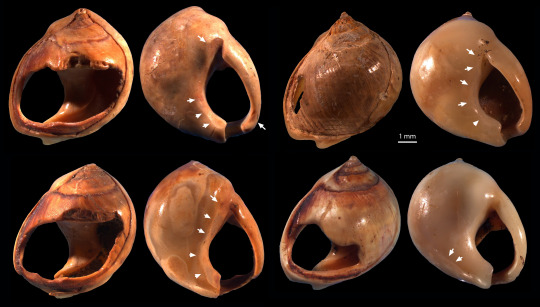
F. d’Errico [modified after d’Errico et al.
Beads of various materials, starting with shells and stones, spread widely with some speculating that trade of beads is what helped with the development of spoken language. It's even possible that beads go back as far as 500,000 years, to Homo erectus, though that is debated. Whether the beads were used in adornment or used as a type of currency or trade medium only is not known for sure, but beads are widely distributed and the materials show evidence of travel (for example, marine shell beads found in landlocked areas). It is thought, though, that wearing of beads came after decoration of the body with ochre.
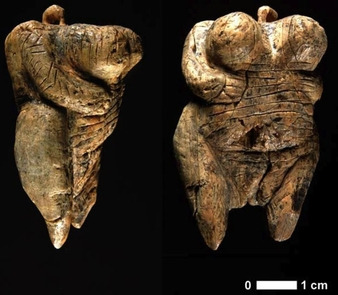
By http://www.nature.com/nature/videoarchive/prehistoricpinup/ image copyright H. Jensen / Universität Tübingen, Fair use, https://en.wikipedia.org/w/index.php?curid=22799118
The earliest depictions of clothing we have is around 41000 years ago, with the Venus of Hohle Fels, which was found in Sweden, though it is possible that the decorations on the body of the Venus figurine is ochre or tattoos. Interestingly, the oldest known musical instrument, a bone flute, was found near the Venus figure, indicating that fully behaviorally modern humans lived in the area.
Based on studies of head and body lice, humans began wearing clothing about 107,000 years ago. Part of the need for clothing was that this time was that this was during the start of the Last Glacial Maximum, when temperatures started dropping and glaciers began overtaking the northern latitudes. Humans, both Neanderthal and Homo Sapiens, had spread quite far by this time. Humans developed in the steppes of Africa and weren't well adapted to the cold, with no real body hair to hold in body heat.


F. d’Errico.
Due to the organic nature of clothing, it's difficult to say for sure when exactly clothing began to be worn and what it was, but we are relatively certain that the first clothing was likely hides of animals. We have found stone and bone tools used to scrape hides from the Early and Middle Pleistocene. These tools also hold evidence that Ochre was used to color the hides. Awls, which were used in southern Africa approximately 73,000, years ago show that hides were pierced beginning very early. These awls show wear patterns of being used on soft, well-worked hides, though whether for clothing or bags, we can't know for sure. These awls spread to Europe by 45,000 years ago, though likely manufactured by Neanderthals based on the theorized distribution of various hominoid groups and remains in the locations they were found.
The benefit of using an awl to create holes in leather is that it can be shaped to the human body, making it more efficient at keeping the body warm, thus reducing the number of layers that need to be warn and allowing humans to spread further during the Last Glacial Maximum.
Approximately 40,000 years ago, in the Denisova Cave, at the time inhabited by modern humans, the first evidence of awls with eyes, or what we now know as needles, appear. This indicates that sewing together clothing, or the decoration of clothing, was becoming more common and more efficient. These needles spread widely, either through trade, contact, or independent development widely, even to the Americas and Australia. It is thought that this led to clothing being decorated more elaborately with beading and other forms of decoration.
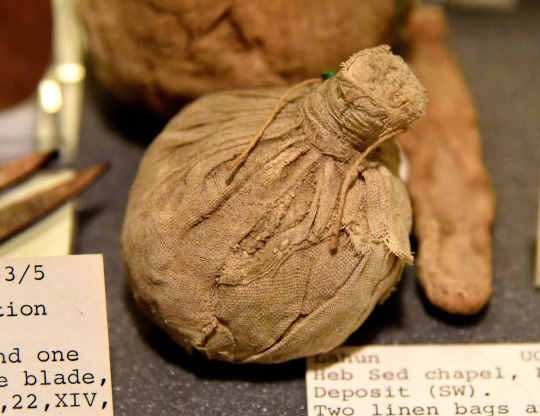
By Osama Shukir Muhammed Amin FRCP(Glasg) - Own work, CC BY-SA 4.0, https://commons.wikimedia.org/w/index.php?curid=56200885
While plant fibres don't generally fossilize, we do have some early evidence of people using them as early as 50,000 BCE, possibly used by Neanderthals, in southern France. There is are scattered imprints of cordage and net imprints in clay. As the planet warmed and the Holocene began, weaving of plant and animal fibres, depending on the local climate and availability. While weaving may have begun as early as 25,000 BCE, flax cultivation began around 8000 BCE, and the first evidence of weaving in 6000 BCE, used as a grave wrapping in Çatalhöyük. Approximately 3000 BCE, sheep were domesticated and bred for wooly fleece as opposed to hair in the Near East. In the Indus Valley, cotton was domesticated around 2500 BCE. Evidence of weaving beginning around 10,100 BCE have been found in the Americas, specifically Guitarreco Cave in Peru, where cotton and llama and alpaca were domesticated. Intricately dyed and woven silk was well developed as a craft as early as 2700 BCE, with the first silk reaching other places in the world nearly a thousand years earlier with the very first evidence of silk being used at all dating back to 8500 BCE.
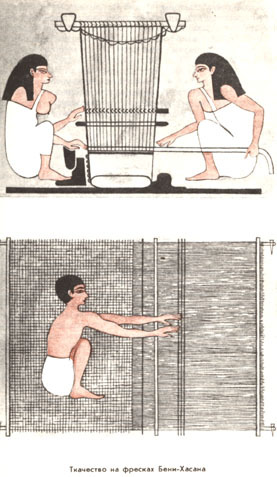
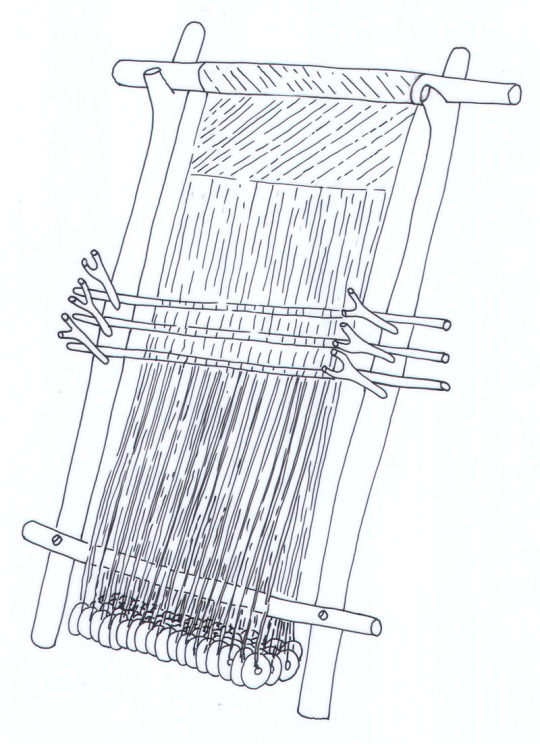
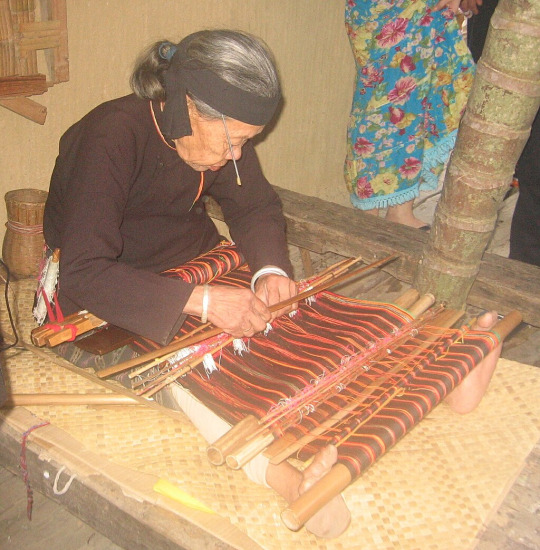
By Unknown author - http://www.booksite.ru/fulltext/nee/lov/tka/che/stvo/1.htm#1, Public Domain, https://commons.wikimedia.org/w/index.php?curid=7483824 By Annika Jeppsson og Danmarks Grundforskningsfonds Center for Tekstilforskning (CTR), Københavns Universitet, Attribution, https://commons.wikimedia.org/w/index.php?curid=33188674 By Zhou Guanhuai - Own work, CC BY-SA 4.0, https://commons.wikimedia.org/w/index.php?curid=142167208
It seems that civilizations may have developed weaving independently, so the first type of loom is difficult to figure out as some locations show that floor looms were first, while others show evidence of hanging looms, and yet others, it seems that what is now known as a 'back-strap loom' was first, while other locations show the use of a floor loom first. Given that these objects were made mostly of organic matter, the evidence comes from art, loom weights (stone or clay weights used to keep the warp threads taut while the loom was in use. Egyptian art shows the use of floor looms, Grecian urns show the use of warp-weighted looms, many native cultures used back-strap looms prior to European contact and colonization. From what fabrics that have been found, each culture developed its own method of creating decorated fabric, either through the application of decorations or through the weaving of the fabric itself, as well as multiple weights of cloth, from fine gauze through thick rugs out of nearly any plant or animal material that could be twisted into yarn.
#body decoration#weaving#sewing#leather work#floor loom#warp weight loom#back-strap loom#fabric#human history#human development
69 notes
·
View notes
Text
if I/we made a blog to share terms and infodumps¹ from our major-related classes², ¿would y’all be interested & follow it?
(¹ and potentially ¿list some research papers/informational books on certain topics?)
(² which are Psychology & Human Development; ✨scary social sciences✨ (/lighthearted))
clarifying, we can’t legally share PPT slides or disclose stories with other students’ or professors’ identifying information.
but we can synthesize, share snippets/quotes, & infodump about what a topic of discussion led us to wonder / research, or what sparked a desire to add to research/what we want to research because of what we learned³.
(³ we want to, eventually*, be a researcher. there is a massive gap in HD/psych on neurodivergent & LGBT+ development & differences, & with the current research we don’t know where Complex-PTSD and ADHD begin/end with one another. I/we have so many unanswered questions that need new researchers to answer, so we’re gonna become a new researcher)
(* here/now to & through grad school is a long time ���� so much schooling, so far to go— but like...the chance to add to the research... 👀🥺)
(** ¿is there actually overlap (or significant overlap), or is it because our society/societies currently don’t produce non-traumatized ADHDers/neurodivergent folks? what does neurodivergence look like without trauma? we don’t know yet.)
✨🎵🎶✨
¿why is this coming up now? here’s some shares/infodumps of what sparked it today 😅💜
🎵
quotes that stand out:
“Humans are not thinking creatures that can feel; we are feeling creatures that can think.” (Dr. R)
“You can sacrifice morality for membership.” (Dr. R)
“We never stop becoming who we are.” (Dr. R)
“We nurture nature.” (Dr. R and Dr. W, at separate times & in different contexts)
“Just because a relationship doesn’t last doesn’t mean it was pointless or it failed. It still meant something; it still influenced who you are and who you want to become.” (Dr. R)
“I don’t believe you were ever so bad that you deserved to be hurt.” (Dr. W)
((yes most of these are Dr. R, as she is more likely to go on tangents (/affectionate), but both of them say impactful things. I’m also leaving out a couple quotes from both of them; these hit me/us the hardest.))
🎶
~~~~
🎵
some concepts/curiosities from this week (cutting off because this part will be long):
(1) Theory Of Mind. ¿Is this why “neurotypical” people say we (neurodivergent, especially autistic/ADHD) lack empathy? ¿Because we struggle with Theory Of Mind?
(2) Theory Of Mind seems to be an almost automated process for mid-adolescents up (about 14 or 15 onward), if they are “neurotypical”/“normative”. In my experience as an auDHDer, this is a manual process I have to walk myself through, and it’s a lot of steps. ¿Do neurodivergent folks typically do this manually/slower, or is that a me thing (or disability impact)?
(3) (this week) From the conversations I’ve had with older classmates & our parents, it seems like people roughly 40+ years old were told “you are [insert identity]” as a concrete, non-negotiable fact. This especially applies to gender identity¹ and sexuality². This leads to what psych/HD call “identity foreclosure”, which means you are highly committed to an identity but haven’t explored other options. In this case, we see it manifest as defensiveness or even aggression if their gender identity &/or sexual/romantic orientation are called into question. The people who felt comfortable disclosing said they feel the need to panic because that was “the one thing [they] didn’t have to question” as they navigated identity formation, so it was the only thing they felt they could count on even when everything else changed (e.g. transition to parenthood).
I don’t have a question or direction to this, but I find it fascinating. ¿Maybe this is a future avenue of study (& maybe future trauma therapy for older adults)?³
(¹ as tied to biological sex - e.g. “you’re a man because you were born male”)
(² you are straight because that is the only option/the only safe option; you are bad/need to panic if you find someone of the same biological sex attractive)
(³ I’m not saying this applies to every single human to live across all cultures & time. But it’s a trend I’ve noticed, & I’m curious to see in which populations & under what circumstances this occurs most.)
(4) One of our professors today made an important distinction that little kids* sometimes “say something factually incorrect”, but cognitively lack the foundations to lie. (In order to lie, you need Theory of Mind. Defining that is a separate tangent.)
(* barely speaking to around 5yo in “normative” development)
This led to a definition of lying (by the social science community) that I’ve never heard before, but made so much sense afterwards: “Lying is when you say something factually incorrect because you understand the other person will act on the incorrect information. You lie in the hopes of eliciting a particular response.”
Usually little kids lie because they are learning & testing Theory Of Mind. ”¿Do you really not know what I do?”
Older kids, teens, adults tend to lie when they don’t trust someone. “If I tell the truth, you might...” (abandon me, hurt me, laugh at me, etc.). That can be because they actually have reason to worry (maybe that person has established an unsafe pattern), or because trauma or because PTSD or another mental illness (anxiety, etc.) makes it difficult to trust people.
That’s not to say that people don’t lie to manipulate (/neg) others. Some people do lie because they see relationships as transactional and want something out of you, or because they want to benefit from or use something you are/have. Some people lie about their income so they can splurge on a fun new toy**, or lie about how much money/resources they have so you’ll hand over some of yours. Some people do lie to hurt others or to unfairly gain from them.
(** or, personal anecdote from my family, lie about the amount of a paycheck so they can secretly spend $300 on a small business license)
But the people I/we know who lie the most are lying because they feel unsafe.
They lie to their romantic/sexual partner because they feel like love will be rescinded if they tell the truth. They lie to a friend that they’re okay because they feel like they will be criticized/a burden if they open up.
The expectation of harm/abandonment, the anticipation of pain, the emotional response of feeling unsafe, these are valid. The conclusions based on them may or may not be true.
(In simpler terms, their emotions are real & their trauma is valid, but the people they apply this experience/these emotions to may be different. They may feel like their romantic partner will rescind love if they admit they’re struggling, but later find out their partner wants to support them through that struggle & begin to heal through/grow out of those expectations.)
🎶
~~~~
✨🎶🎵✨
That was quite a long one but,, yeah. I’m thinking a lot about Theory of Mind today, & its role in trauma/neurodivergence & lying, as well as lying as a concept.
If anyone got this far/enjoyed this, please let me/us know.
I may still make a blog anyway, but wanna assess potential interest throughout the hellsite (/affectionate) & especially among my followers/mutuals (who will likely see some of those posted reblogged/engage more often than most).
#psychology#theory of mind#psychological theory#healing#healing from trauma#infodump#special interest#~Nico#potential blog#social science#human development#empathy#identity#psychology of lying#lies#lying#pondering#wondering#excited#intrigued#identity foreclosure#full time student#university#university student#college#actually autistic#neurodivergent#actually adhd
3 notes
·
View notes